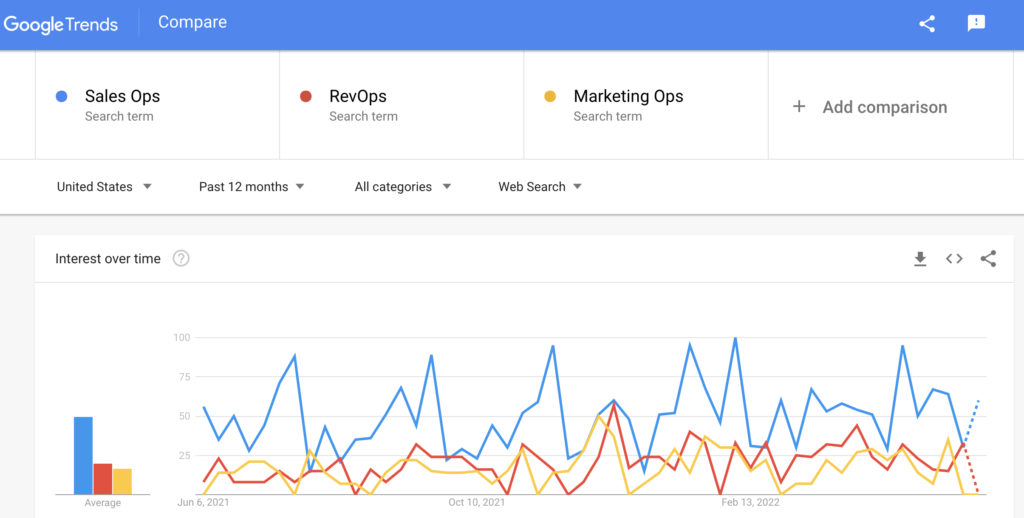For a handful of years now, LeanData has drummed a steady beat of extolling the virtues of Revenue Operations, or RevOps. And, according to our own research studies at LeanData, well over half of companies have dedicated RevOps groups in place. Furthermore, adoption is growing at an increasing pace as companies move toward modern revenue orchestration.
Still, there’s great confusion on revenue teams about Revenue Operations, not only what RevOps is, but how RevOps relates to the previously established functions of Sales Operations and Marketing Operations.
Those legacy Sales and Marketing Operations are still very relevant in revenue team processes. In fact, according to searches, Sales Ops is the most searched of the three terms.

This post will cover the key differences between Revenue Operations, Sales Operations and Marketing Operations. Most importantly, it will cover how they work together to facilitate modern revenue orchestration.
What is RevOps?
The term “revenue operations” means many different things to many different go-to-market practitioners. It can be a role and/or a function, but most importantly, it’s a strategic concept built on the principles of unification and collaboration.
As a revenue team strategy, RevOps aligns the various departments of the revenue team and ignites the revenue engine. That’s a critical concept too, as SiriusDecisions (now part of Forrester) found companies that aligned revenue operations grew 12-15 times faster than their peers and were 34 percent more profitable..
Alignment facilitates collaboration across the revenue team. By sharing data, common metrics and transparent reporting, Sales, Marketing and Customer Success groups ensure everyone works toward common goals and objectives.

What is Sales Ops?
Sales Operations, also known as Sales Ops or SOps, is a function that oversees and administers the business processes, activities and technologies that empower a Sales team to perform both efficiently and effectively.
Sales Ops exist primarily to ensure the Sales team runs smoothly and efficiently. Sellers are not effective if they’re inundated with non-selling tasks. Sales Ops keeps the data and processes organized so sellers can stay dedicated to selling.
What is Marketing Ops?
Marketing Operations, often referred to as Marketing Ops or MOps, is a function that oversees and administers the business processes, activities and technology that empower a Marketing team to perform both efficiency and effectively in deploying its strategies and reaching its own objectives.
Marketing Ops manages its part of the RevTech stack to, among other things, ensure clean and accurate reporting. As a function, it also tends to work with an eye toward scalability. So, MOps lean into process automations to scale sustainability while maintaining the prospect and customer experiences.
RevOps at the intersection of Sales Ops & Marketing Ops
Sales Ops and Marketing Ops tend to be very similar. However, they also tend to serve the best interests of their particular function and, over time, frequently end up siloed off from others outside of their function.
You undoubtedly read ad nauseum about Sales and Marketing alignment. But, there’s a good reason for that, and that’s because alignment between Sales and Marketing is an ongoing concern. It never stops, and it never should.
Check out the infographic, “A Different View: How Ops the State of Lead Management 2022.“
Demand generation and closing deals are the primary objectives of Marketing and Sales teams. As a result, they tend to move forward full steam ahead in the accomplishment of their main objectives.
As one function moves forward, care must be taken to ensure the other function follows along in lockstep. Breakdowns in alignment evolve into revenue team chaos, and prospects and customers are the first to feel it in their experiences. Then, the revenue team tends to feel it with low to no revenue growth.
With the customer journey front and center, RevOps brings the potentially disparate functions of Sales Ops and Marketing Ops together in a purposeful and intentional manner. RevOps starts and ends with optimizing the customer journey in mind. Within those parameters, Sales Ops and Marketing Ops work to move the needle for their respective functions and business.
RevOps and the future of the revenue team
The nature of selling has changed. Even prior to the pandemic, B2B sales were trending to be more and more digital-based. The pandemic only accelerated that transformation.
B2B buyers are now decidedly digital-first, and that places a premium on a company’s RevTech stack to work quickly and seamlessly. Prospects have choices, and they can move from one option to another at the speed of the internet.
The pandemic has also changed the way the revenue team works, and most importantly, how its various functions work together. Many Sales and Marketing teams no longer share office space, where face time led to informal conversations that eventually turned to continuous improvement projects.
Technology-integrated work processes benefit from RevOps’ strategic overview of the revenue side of the business, particularly the day-to-day machinations of how internal teams, processes and customers interact and engage. Going — and growing – forward requires RevOps to align the business to the customer journey, not the other way around. Doing so enables a business to predictably scale, regardless of its size or industry.











